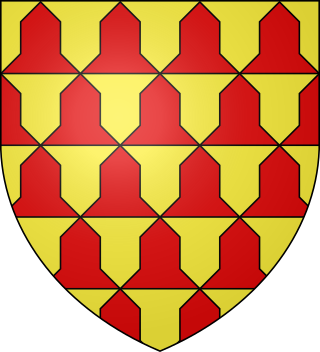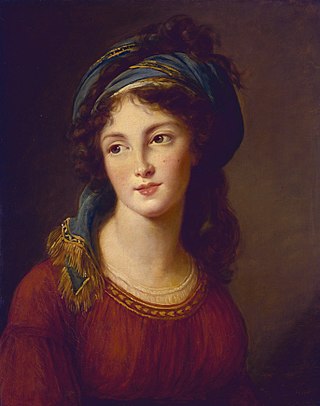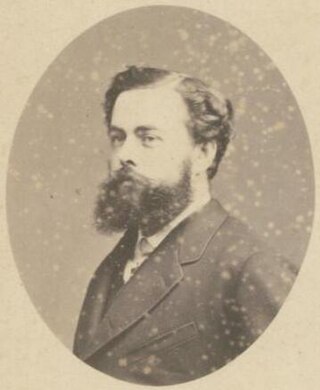
The title of Duke of Polignac (French: Duc de Polignac) is a French dukedom that is held by the Polignac family.

The title of Duke of Polignac (French: Duc de Polignac) is a French dukedom that is held by the Polignac family.
The title was originally created for Jules de Polignac in 1780 by brevet, which meant it was not hereditary. It was made heritable in 1783 according to masculine primogeniture. [1] In 1817, the holder was made a peer of France, granting him the right to sit in the Chamber of Peers of the Bourbon Restoration.
The third duke, Jules, a younger son of the first duke, was created (before his succession to the dukedom) a prince of the Papal States in 1820, authorised to bear the title in France in 1822, and granted the same title in the Kingdom of Bavaria in 1838, which extended it to his male-line descendants.[ citation needed ] Thus, the descendants of the third duke bear the title of Prince (Fürst) or Princess (Fürstin) de Polignac, while members of the family descended only from the first duke use the title of Comte or Mademoiselle de Polignac.
The wife of the first duke was the famous Yolande de Polastron, a favourite of Queen Marie Antoinette. The mathematician Prince Alphonse de Polignac, soldier Prince Camille de Polignac and composer Prince Edmond de Polignac were younger sons of the third duke. Princess Edmond de Polignac, wife of the last named, was the American heiress Winnaretta Singer. Comte Pierre de Polignac, a great-great-grandson of the first duke, married Princess Charlotte, Duchess of Valentinois and was the father of Rainier III, Prince of Monaco.
The Most Serene House of Bourbon-Condé, named after Condé-en-Brie, was a French princely house and a cadet branch of the House of Bourbon. The name of the house was derived from the title of Prince of Condé that was originally assumed around 1557 by the French Protestant leader Louis de Bourbon (1530–1569), uncle of King Henry IV of France, and borne by his male-line descendants.

Jules Auguste Armand Marie de Polignac, Count of Polignac, then Prince of Polignac, and briefly 3rd Duke of Polignac in 1847, was a French statesman and ultra-royalist politician after the Revolution. He served as prime minister under Charles X, just before the July Revolution in 1830 that overthrew the senior line of the House of Bourbon.

Prince Pierre of Monaco, Duke of Valentinois was the father of Rainier III of Monaco. He was a promoter of art, music, and literature in Monaco and served as the head of the country's delegation to the United Nations Educational, Scientific, and Cultural Organization (UNESCO) and to the International Olympic Committee.

Mathieu Jean Felicité de Montmorency, 1st Duke of Montmorency-Laval was a French statesman during the French Revolution and Bourbon Restoration. He was elected as the youngest member of the National Assembly in 1789. He is also known for his military expertise and his relation with Mme de Staël. When France became a republic, Montmorency turned into an ultra-royalist. Napoleon regarded him as a member of the Catholic opposition. During the Restoration, he became Minister of Foreign Affairs.
Count of Guise and Duke of Guise were titles in the French nobility.

Yolande Martine Gabrielle de Polastron, Duchess of Polignac was the favourite of Marie Antoinette, whom she met when she was presented at the Palace of Versailles in 1775, the year after Marie Antoinette became the Queen of France. She was considered one of the great beauties of pre-Revolutionary society, but her extravagance and exclusivity earned her many enemies.

Duke of Mouchy was a hereditary title in the peerage of Spain, accompanied by the dignity of Grandee and granted in 1747 by Ferdinand VI to Philippe de Noailles, a French military officer. After failure of the 1st Duke's successors in inheriting the dukedom through the established legal procedures, the title expired in the Kingdom of Spain. Withal, it was bestowed by Louis XVIII of France on the eldest son of the 1st Duke in 1817 as a title in the French peerage.

The House of Bauffremont is the name of a French princely family which derived its name from a village in the Vosges, outside of Neufchâteau, now spelt Beaufremont. The family traces itself to Liébaud, sire de Bauffremont, in 1090. They are descended from the female line of the House of Courtenay.

The House of La Trémoïlle(Maison de La Trémoille in French) was a French noble family from Poitou whose name comes from the village La Trimouille in the department of Vienne. This family has been known since the middle of the 11th century, and since the 14th century its members have been conspicuous in French history as nobles, military leaders and crusaders, and influential as political leaders, diplomats, Huguenots and courtiers. The male line of the family died out in 1933, while female line heirs of the last duke have kept the La Trémoïlle surname alive in Belgium.

A prince du sang or prince of the blood is a person legitimately descended in male line from a sovereign. The female equivalent is princess of the blood, being applied to the daughter of a prince of the blood. The most prominent examples include members of the French royal line, but the term prince of the blood has been used in other families more generally, for example among the British royal family and when referring to the Shinnōke in Japan.

Philippe Jules Mancini, 8th Duke of Nevers (1641–1707) was the nephew of Cardinal Mazarin, chief minister of France immediately after the death of King Louis XIII. He was the brother of the five famous Mancini sisters, who, along with two of their female Martinozzi cousins, were known at the court of King Louis XIV of France as the Mazarinettes.

The title of Duke de La Rochefoucauld is a French peerage, from the great House La Rochefoucauld, cadets of an ancient House of Lusignan, whose origins go back to Lord Rochefoucauld in Charente in the 10th century with Foucauld 1st (973–1047), first Lord of La Roche then La Rochefoucauld, possibly son of Adémar, Lord of La Roche (952–1037). They got the title of Baron in the 13th century, then became Count in 1528 with François I de La Rochefoucauld, godfather of King François I and in 1622, François V de La Rochefoucauld was made Duke by Louis XIII. He married Gabrielle du Plessis-Liancourt, daughter of Antoinette de Pons, and their son François VI was a leading figure of La Fronde and the author of the Maxims. They are also, since 16th century, Prince of Marcillac. François VII, best friend of Louis XIV, married Jeanne du Plessis-Liancourt. Their son François VIII became in 1679 Duke of La Roche Guyon and married the same year the daughter of Louvois, Madeleine Le Tellier. Then they become during the 18th century: Duke of Liancourt, Duke of Enville and Duke of Estissac. Afterwards: Prince de La Rochefoucauld-Montbel, Duke of Doudeauville, Duke of Estrées and Duke of Bisaccia. They are also: Marquises of Montendre, of Barbezieux, of Surgères and Bayers; also Count of Duretal, Count of Roye and Roucy, Count of Blanzac, Count de La Rochefoucauld-Montbel and Baron de Verteuil. They were: Blessed of the Catholic Church, cardinals, bishops, grand maîtres de la garde-robe and Grand Huntsman of France, chambellans, ministers, lieutenants general of the armies, UK field marshal, Denmark marshal, ambassadors, grand hospitaller of the Order of Malta, a hero and spy during WWII, presidents and founders of multiple clubs. Many of them were elevated in the Order of the Légion d'Honneur and around 40 of them were/are members of the Sovereign Order of Malta. The castle of La Rochefoucauld has been in the family since the 10th century. The La Rochefoucauld-Montbel owned the Lascaux caves at the moment of their discovery and are closely linked to the Pellevoisin sanctuary in France.

Hercule Mériadec de Rohan was a prince étranger and the sixth Duke of Montbazon in France, "Prince de Guéméne" being the title he bore prior to inheriting the dukedom.

Jules de Polignac, 1st Duke of Polignac was a French nobleman and the husband of Yolande de Polastron, a confidante of Queen Marie Antoinette. He became the first Duke of Polignac in 1780. He died at the age of seventy one in Little Russia, where he was given a manor by Catherine the Great.

Aglaé Louise Françoise Gabrielle de Polignac was the daughter of Gabrielle de Polastron, the favourite and confidante of Marie Antoinette, and her husband, the 1st duc de Polignac.

The House of Polignac is the name of an ancient and historically powerful French noble family that took its name from the château de Polignac, of which they had been sieurs since Carolingian times. Agnatically, ruling family of Monaco represents the cadet branch of the House of Polignac.

Diane Gabrielle Damas was a French noblewoman and Aristocrat, she was born into the; House of Damas as the daughter of Claude Leonor Damas, the Marquis of Thianges. Diane was also thought to have been a mistress of Louis XIV and a member of the Order of the Honey Bee.
Honoré-Louis d'Albert de Luynes, styledDuke of Chevreuse, was a French nobleman.

Charles Honoré Emmanuel d'Albert de Luynes, 9th Duke of Luynes was a French aristocrat and soldier in the Papal Zouaves.
Paul Marie Stanislas Honoré d'Albert de Luynes, 10th Duke of Chaulnes and Picquigny was a French aristocrat, soldier and writer.